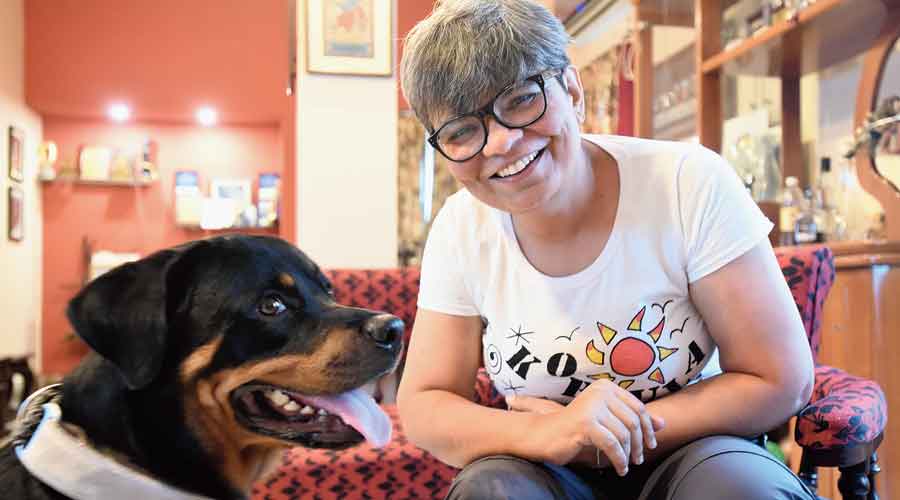Outside of a dog, a book is a man’s best friend. Inside of a dog it’s too dark to read, Groucho Marx had said. It is a dark, funny and clever observation, but it may not be true.
If you are talking to Paramita Das, dog trainer and behaviourist, you may even come to believe that the inside of a dog offers quite a lot to read.
Das, 47, a resident of Salt Lake, trains dogs and reads their minds. It is nothing fancy. She helps dogs with behavioural problems, such as aggression. Talking to her you feel that what she practises is a deep form of engagement, the kind that a human usually only reserves for a human, thereby questioning our entire attitude towards other animals. It requires imagination, sympathy and a readiness to accept an unsettling view of ourselves. As Elizabeth Costello, the character created by J.M. Coetzee, had asked disturbingly, upsetting so much around her: “Why can’t we share the being of a bat?” Because “a living being that does not do what we call thinking is somehow ‘secondclass’.” But why is that, Costello asks. Why indeed?
In our arrogance, we also expect other animals to be like us. Anthropomorphism, the tendency to attribute other animals with human characteristics, is something Das is extremely wary of.
At the very beginning, Das, in her lively, brisk, clear and pleasant manner, states two facts that are basic, but she must have her reason for reiterating them. One, dogs are not human. Two, they do not speak. A lot of the problems with which “pet parents” – she likes to use this phrase instead of owners — approach Das would not perhaps have occurred if these were kept in mind. But they do, mostly when the dogs begin to ignore toilet habits, or become destructive or aggressive, or begin to bite.
“I have to understand why the dog is doing what he is doing,” says Das, who left a senior corporate job to become a dog behaviourist. “If there’s a sudden change of behaviour, I send the dog to a vet.” If a medical condition is ruled out, Das takes over.
Dogs try to tell us that they are uncomfortable. They use body language to show how they are stressed. At first they send calming signals, such as yawning or nose-licking, or they sniff the floor, which show low-level stress. As the stress escalates, the tail will be tucked in and the ears will go back. In the red zone, he will growl, lunge or bite.
Das tries to understand what is bothering the dog by looking at these signals, which are fairly simple. But the body language of the humans accompanying the dog is also telling. “Only 7% of human communication is verbal. The rest is expressed through tone, expressions and body language.” But understanding the humans is not so easy. However, the dog and the pet parent often end up revealing their story together, a story in which the latter often unwittingly plays a crucial role.
Fear is often the key. A dog reacts from two main instincts: fear and frustration, says Das. If he is aggressive, it is very likely that it is acting out of fear, possibly of a human.
So even a “friendly” dog can bite. Maybe he is afraid of the visitor, too tall for his liking, and he is being forced to be patted by the visitor. Out of fear, the dog will attack the unsuspecting person.
If a pet parent is too indifferent, as it often happens, the dog, just to get his attention, will run away with objects that he should not. The human will start screaming, but the dog will only be pleased, because he is finally getting the attention. “But the pet parent started it,” says Das.
A dog needs attention, to its emotions and also to his physical nature, stresses Das. A dog needs its run, another vital aspect that is ignored about dogs in city homes. “Even keeping dogs from cold parts of the world in AC rooms is fine,” says Das, but not giving them exercise is just not on.
“A dog is an active animal,” she says. “Various kinds of dogs are good at various kinds of activities. Labrador Retrievers would work with fishermen. They would pull the fishing net out of the water. A Husky was bred for endurance and used as sled dogs and later as a racing breed,” says Das. People think of the small, cute beagle as most suited for an apartment. “But a beagle is a scent dog. He can be kept in an apartment, but he has to have scenting games organised for him inside which will also challenge him mentally, which he enjoys. A tired dog is a happy dog.”
One wonders how dogs in homes are faring during the lockdown. It is tough. “But they are also getting their pet parents’ company. In fact I am worried that when the lockdown is over they will suffer from separation anxiety,” says Das.
She warns against more anthropomorphic behaviour. Most dogs do not take naturally to cuddling or hugging, she says. “Hugging is primate behaviour and dogs are not primates,” says Das. Besides, they are flight animals; like lions and tigers they flee when they see danger and do not fight, like humans do. “So if you are hugging the dog, you are denying him the flight option.” Things may go very wrong then.
At this point I feel I should take a close look at my behaviour in general, especially what I impose on others, including on dogs, in the name of affection.
Das once had a pet dog. But when the dog died, she did not get another dog, but her love for dogs remained. Born and brought up in Chennai, she studied MBA in Calcutta and worked in the corporate world from the 90s. After about a decade or so, began to think of doing something else.
In 2012, with her friends she opened Paw Path, a diagnostic centre for animals in the city. In 2015, she left her job as a HR professional in TCS to become a dog trainer and behaviourist. She trained – and keeps training -- with Shirin Merchant from Mumbai and John Rogerson, who is from the UK. She travels extensively, everywhere on earth, from “the Arctic to Antarctica” she laughs, with her filmmaker husband, who also gave up his corporate job to pursue his passion.
“The most important thing is a strong relationship, based on love, respect and trust, on both sides,” says Das. She adds that if she had known so much about dogs earlier, it would have helped her as a HR professional.
So much reason to question the hierarchy of the animal world.











